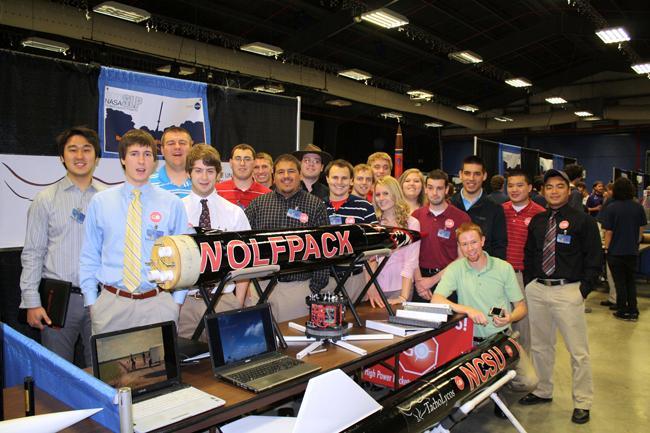With a successful test launch under its belt, the members of the N.C. State Rocketry Team feel confident about their next competition hosted by NASA this week. The challenge: design a rocket that can launch at least 5,280 feet, or one mile, into the air.
On their test, they hit an altitude of 5,800 feet. Team president Josef Khalil anticipates a better result this weekend.
The Rocketry Team, started three years ago, was formed to compete in NASA’s national rocketry challenge. The group has continued to grow since its formation, competing in this year’s challenge.
“We had our full-scale launch in Bayboro , North Carolina, and it was pretty successful,” Khalil , a senior in mechanical engineering, said. “Except for a few modifications, we have finished up the rocket that will compete this year and would say we are 95 percent done.”
NASA hosts the University Student Launch Initiative every year in April, according to Khalil . The scientific payload, or the specific objective for the competition, changes every year.
The carbon fiber rocket is 112 inches long and 5.5 inches in diameter, with a fiber glass nose cone, according to Khalil .
The path to the competition was not easy, and one of the major hurdles the team had to overcome was raising enough funds to build the rocket. With limited resources, Shawn Marooni , a sophomore in chemical engineering, raised funds through crowd-sourcing on Kickstarter , a donation social network.
“This year we had a lot of trouble in getting funds from space grants,” Khalil said. “[Through Kickstarter], we actually raised $2,500 in one month and got to our target. People from all over the world donated money to us.”
The competition will take place at the U.S. Space and Rocket Center in Huntville, Ala., from April 18-22. NASA will host 50 other teams including MIT, Georgia Tech, Utah State and Virginia Tech.
Students don’t need a specific major to join the team, but just an interest in rockets. According to Khalil, teammates will learn all they need to know from hands-on experience in the group.
“Most of our new freshmen and sophomore members actually built the parts of rocket, and many of them are going to become officers next year,” Khalil said.
Though Khalil said the task of designing a rocket has been a challenge, the experience will boost employment options.
“It is a great thing to put on your resume, to say that you worked under NASA supervision and competed in NASA competition,” Khalil said. “Your experience is of a full engineering design project. First you brainstorm on the design, then you build it, use the simulator and detect the problems and solve them. It is a very good experience.”
Brendan Carr, senior in mechanical engineering and outreach coordinator in the club, said the team’s activities extend beyond rocket science.
“We are required by NASA to reach out to a minimum of 100 middle school students… and teach them about rocket science in general,” Carr said. “My job is to call local schools and see if they would like us to come out for a couple hours and tell students what goes into rocket making…”
He said the club’s activities are intensive and members needs to stay on their toes all the time.
“The work in the club is no joke and requires serious commitment and dedication,” Carr said. “It also takes up a lot of time outside of school work, so time management is important to become a member of this club. One needs to keep up with emails, updates from groups and basically stay on his or her toes.”
According to Cameron Lowe, team vice president and senior in aerospace engineering, the experience in the group is worth it for the lasting impression it leaves on the recruiters at industry career fairs.
“It is a great activity and experience to talk about when talking about experience with engineering, and it turns out to be a great conversation starter in career fairs,” Lowe said.
The team still has its work cut out this week. But if all goes well, the members of the team may be primed as good applicants for jobs in the aerospace industry. If so, the sky’s their only limit.








